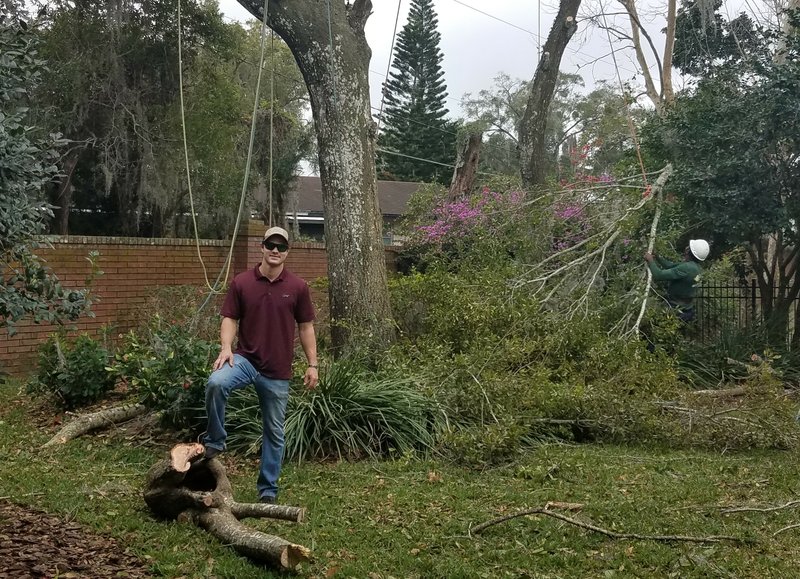If a tree falls in the forest, and no one is around to hear it, does it make a sound?
I have no idea. I leave that question to the philosophers and physicists. But I do know that if a tree in your yard falls on your house while you're in it, you darn well will hear it. And the sound will make your heart jump out of your chest like the creature in Alien, and your emergency savings fund will disappear faster than a puff of pollen.
That scenario was precisely the one I chose to avoid when I had the old water oak tree removed from my yard this week. Though I was sad to see her go, I decided it was better she leave on my terms than on hers.
The old oak was nearing the end of her years, two arborists told me. Hurricanes had damaged her once regal crown. Now, where branches had once been, open cavities the size of wastebaskets pocked the trunk, opening doors for decay.
"We won't know till we get up there how bad it is, but I can tell you she's compromised," said Alec Lantagne, a certified arborist and partner at The Sunbelt Tree Service, which serves Central Florida.
He pointed to a section of root that was beginning to lift. "This indicates instability."
I look up into the canopy of the 50-foot tree, a big part of the landscape around here, and feel sad.
I turn tables and ask, "If this tree were in your yard, would you cut it down?"
He thinks a minute. "I wouldn't have a water oak near my house," he said.
I don't just take his word for it. I do some research. Unlike live oaks, those sturdy majestic soldiers that can live for hundreds of years, water oaks only live 50 to 60 years. Like a bad marriage, when they fail, they can take a house with them. "Water oaks, sometimes called laurel oaks are fast-growing, short-lived trees that don't do well in hurricanes," read one report. Great. "Laurel oaks are not very good at containing decay, so it spreads throughout the tree," said another. Fantastic.
You only have to live through one hurricane and see the aftermath of trees on their sides, lying on fences, cars and roofs, to realize you don't get to pick which way a tree falls or when.
"I didn't become an arborist because I don't love trees," Lantagne said, sensing my resistance. "Trees are important for the environment. They provide shade and beauty and homes for wildlife, but sometimes they need to come down. This is one of those times."
If she didn't topple over, she was on the verge of dropping large sections, he said, and with wood that weighs 80-pounds a square foot, that's not a blow you want to take.
Here's what else I learned about tree removal:
Ask before you cut. Find out the rules in your town, and check with your homeowner's association before you remove a tree. Many cities require you to get a permit first. If the tree is dead or diseased, you shouldn't have any trouble getting permission.
Assess your risk. Disease and instability are the most common reasons homeowners have trees removed. Arborists can help tree owners determine their liability by noting the tree species, the extent of its root system, its age and health. They look for signs of beetle infestation, cavities, fungus, trunk discoloration, or other signs of compromise. "Companies with certified arborists are less likely to take down a tree that doesn't need to come down," Lantagne said. "Sometimes you just need to prune the tree, so it doesn't act like a sail in the wind."
Hire bona fide pros. Taking down a large tree properly and safely is not a job for an amateur lumberjack. It involves math and physics, Lantagne said. When hiring a tree service, look for one that has a certified arborist. Make sure the company carries liability insurance for tree work and workers comp. Lantagne showed me certificates for both without hesitation. Be sure the company is based locally, has good referrals, a legitimate office, and a person easy to reach by phone, not just a P.O. Box and a truck. "A lot can go wrong," Lantagne said. "You want to be sure you're working with a reputable company."
Know the plan. The day before our tree came down, Lantagne came by to figure out where to park his chipper so it wouldn't interfere with traffic, and how to remove sections of the fence for better access. The next day, his crew set up a pulley-rope system and began taking the old oak down gracefully, lowering branches to the ground carefully, almost ceremoniously.
Remove and replace. Some cities require homeowners to replant a tree if they remove one. Even if it's not required, it's nice to do. Soon, three crepe myrtles will stand where the old water oak once was, providing shade and a home for birds and squirrels — minus the threat.
Syndicated columnist Marni Jameson is the author of five home and lifestyle books, including Downsizing the Blended Home — When Two Households Become One (Sterling Publishing, Dec. 2019).
HomeStyle on 02/15/2020

